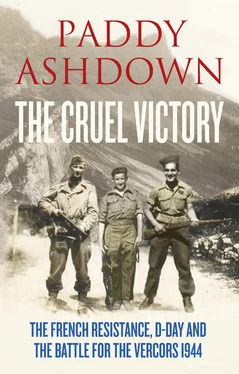That night the whole company had a convivial dinner at the Restaurant des Côtes at Sassenage and the following day accompanied Delestraint on a tour of inspection of the plateau. They went first to Saint-Nizier, the gateway to the northern half of the plateau. Delestraint immediately identified this as the weak point in the Vercors’ natural defences and warned prophetically, ‘Without mountain artillery, or at least mortars, you cannot expect to hold the plain of Villard-de-Lans for very long. In these circumstances it might be best to defend instead the southern, more mountainous part of the Vercors.’
Over lunch in a restaurant at La Balme-de-Rencurel in the Bourne gorges, the old General turned to Aimé Pupin and asked, ‘Why did you choose the Vercors?’
‘Pure romanticism, mon Général,’ Pupin replied. ‘I was always fascinated by the fact that Mandrin [an eighteenth-century brigand with a Robin Hood reputation] was able to escape the police when he took refuge here.’
It had been a good day and Delestraint, who expressed himself well satisfied, thanked everyone for their work and promised that ‘The Vercors will play an important role when eventually the Allies land in France.’
Throughout April and early May, despite Italian Army raids on the camps, the Montagnards preparations continued, including a plan to install a high-powered transmitter in Villard-de-Lans which could be used by General de Gaulle to broadcast to the whole of France when he set up his government on the plateau after the Allied landings. Chavant, Pupin and others even began to search for appropriate houses to be used as de Gaulle’s personal accommodation when he arrived.
This high mood of hope and optimism was reflected in London. On 4 May, de Gaulle addressed a reception for young people at the Grosvenor House Hotel. He said ‘France can return again to her force of arms and her hopes, waiting for the day when, her liberation accomplished and her victories achieved, she can escape from her pains and ruins to claim her greatness and her place among the ranks of the great nations again.’
Despite such intoxicating dreams, there were more prosaic problems which needed urgent solutions – the Maquisards in the camps lacked boots. A raid was duly mounted to appropriate a large number of boots and shoes from a nearby government depot, which were distributed for the comfort of blistered feet across the plateau. This success was followed by several other raids on the valley to obtain what the plateau lacked, attracting the attention of the Italian secret police, OVRA. Whatever the ineffectiveness of the Italian Army, the same could not be said of this organization which worked closely with the Gestapo. On 24 April OVRA agents arrested and tortured Dr Leon Martin, then imprisoned him in the Fort d’Esseillon in Modane close to the Italian border. ‘I sent Benoit to see if it might be possible to spring him,’ Aimé Pupin explained. ‘But he came back saying it was hopeless.’
OVRA’s next chance came not through their own work but through a mixture of complacency, braggadocio and stupidity on the part of the Maquisards. It began one day in mid-May when a garage owner with known Resistance sympathies was asked to hide two full ex-Army petrol bowsers in his garage until they could be collected. He was given a password and firm instructions that he should on no account allow the vehicles to be stolen or captured by the Italians. This was easier said than done since Italian soldiers were billeted in a house not fifty metres from his garage. He made the vehicles safe by chocking them up on bricks, removing their wheels and distributor heads, and repainting them in the livery of the Water and Forestry Department.
For a week or so, nothing happened. But then, when the owner arrived at his garage as usual on 27 May, he found the doors had been forced overnight. The vehicles were still there, though there had clearly been an attempt to replace their wheels. But the bowsers were empty. Two days later the garagist was arrested and questioned by OVRA and accused of providing petrol to the Maquis. Only then did it emerge that the break-in at his garage had been carried out by a team of eleven armed Maquisards from Villard-de-Lans who had attempted to ‘liberate’ the vehicles and take them on to the plateau, where the petrol was desperately needed to keep the Huillier buses running. On the way down from the plateau, the ‘commandos’ had stopped at a bar in Grenoble well known for its Resistance sympathies. Here they met a fellow Resistant leader who, hearing of the exploit, told them that it was extremely foolish, since he could easily get false papers to allow the vehicles to be driven up to the plateau without any risk. But the leader of the Villard commandos insisted on pressing ahead with his plans. Of course, since no warning had been given to the owner, the commando team had no option but to break into his garage, where they duly discovered that the vehicles were immovable. Realizing there was nothing further they could do, they set off to return to the plateau. But, breaking all the normal security rules, they chose to travel back by the same route by which they had come down. At the Pont de Claix just outside Grenoble they ran into an OVRA checkpoint in the early hours of the morning. A search of the back of the lorry revealed that it was full of quietly sleeping ‘commandos’, their arms stacked neatly by their sides. All ten were arrested, interrogated and in due course deported to Italy.
The next day, 28 May, the OVRA and the Milice swooped. A black OVRA car supported by a lorry full of Alpini arrived in Villard in mid-morning and arrested Victor Huillier, four other key Resistance organizers and finally, after a lengthy search, Aimé Pupin himself, hiding in a loft. At the same time, a Milice search of the village turned up a cache of some 6 tonnes of dynamite hidden near by. Almost the entire leadership of the Vercors Resistance had been decapitated in a single morning. Other arrests of those further down the chain swiftly followed. Thanks to fast footwork, Farge, Le Ray, Chavant and Dalloz among the main leaders managed to escape (Dalloz’s wife Henriette Gröll fled her home in La Grande Vigne in the middle of a reception for forty guests moments before Italian troops roared in to take possession of the house). However, thanks to Pupin’s habit of keeping neat centralized records, all were now hunted fugitives.
On 28 May London sent instructions to Delestraint to refrain from all military action. That afternoon Farge had a clandestine meeting with Dalloz in a grove of acacia trees on the Quai de France, alongside the Isère in Grenoble. ‘My friend,’ said Farge, ‘you and I have the money in our pockets and the clothes we stand up in. We have nothing else now. No job, no home, no family, no name. From now on we live the clandestine life, or we don’t live.’ Chavant hurriedly left Grenoble to find refuge in a village west of Grenoble, Farge fled for Paris, Dalloz for Aix-les-Bains and Le Ray for the plateau.
On 2 June, Dalloz received instructions to meet Delestraint in a restaurant in Lyon, where the old General instructed him that Alain Le Ray and Jean Prévost were to take over the Vercors Resistance structures and Dalloz himself was to go to Paris where he should meet the General again on the terrace of the Chez Francis restaurant by the Alma-Marceau exit of the Métro at 18.00 on 6 June 1943. When the two conspirators met in Paris they found the restaurant too crowded for safe discussion, so they walked together to the house where Dalloz had found temporary refuge in Paris. Here Delestraint told Dalloz that, if anything happened to him, Dalloz should go to London where he would help to prepare the way for Plan Montagnards.
Dalloz may have been lucky. Three days after his meeting at Chez Francis, Delestraint was arrested emerging from another Métro station, La Muette, on his way to a meeting with another Resistance leader. He was handed over to the ‘Butcher of Lyon’, Klaus Barbie of the Gestapo, and interrogated for more than fifty no doubt terrible hours, before being sent, as a Nacht und Nebel *prisoner, to Natzweiller-Struthof concentration camp in Alsace. He was shot in Dachau three weeks before the German surrender in 1945.
Читать дальше












